Bob Ritchie, agricultural sales director of David Ritchie Implements Ltd., travelled all the way from Scotland and braved the heat at Ag in Motion in July to showcase his Beef Monitor.
The Beef Monitor tracks the weight of the cattle and provides accurate daily live weights. According to the website of David Ritchie Implements Ltd., the Beef Monitor uses compatible ear tags to record weight and takes data from the ear tag every time the animal walks across the monitor to get water.
“This method simplifies the traditional labour-intensive process of weighing cattle, as it allows for multiple daily weighings without additional labour.
Read Also

What to know before you go to Agribition 2025
If you’re attending Agribition 2025, this is the place to find out about tickets, dates and what’s happening this year.
“Every time an animal goes onto the Beef Monitor, we’re picking up the weight of the animal, we’re picking up the electronic tag number, along with the date and the time and you’re shipping that off to the cloud,” Ritchie said. “At midnight every night, the computer kicks in, and we’ll look at the average weight for each animal for that day. When the farmer gets up the following morning, and whilst he’s at the breakfast table, he can be looking at the actual weights of his animals.”
The Beef Monitor also generates a seven-day average and a 21-day average.
With this monitor, producers can determine when their cattle are losing weight and intervene early.
“Early intervention can help maintain margins,” Ritchie said. “I use that phrase because that’s what the Beef Monitor is all about. It’s all about improving the margin for the producer by providing that type of information.”
Ritchie said they have done work regarding cost justification for the Beef Monitor. He said they have accounted for the time a farmer would spend handling the animals and the labour that goes into it. He said the cost justification also accounts for how farmers can increase the weight of the animals to maximize their earnings from the slaughterhouse without being penalized.
“So you take a mob of 50 animals. And let’s say it’s costing a notional figure of $5 a head a day. So there’s a $250 spread over three or four days, and before you know it there’s $1,000 that the farmer has spent for no gain. So, it’s quite easy to build up a cost justification for this unit.”
Ritchie said their customer base is primarily domestic, or in the U.K. He said they also have customers in the Republic of Ireland, Europe and as far as New Zealand.
He said there aren’t big plans to push the product into North America, but he hopes to enter that market at some point.
“We go for organic growth. We don’t go for engineered growth in any way.”
He said they are currently trialing a water intake measurement, which they hope to implement in the future.
Ritchie also said he hopes beef producers will continue implementing new technology, so that one day, it’s comparable to the grain side.
“From what I’m seeing here in North America and Canada, there seems to be an insatiable appetite for information,” Ritchie said. “And I walk around the Ag in Motion show and I see things from drones, the satellite navigation, all high tech things which are aimed at the cropping side of the industry. And I think there’s a long way to go as far as the livestock is concerned.”

















